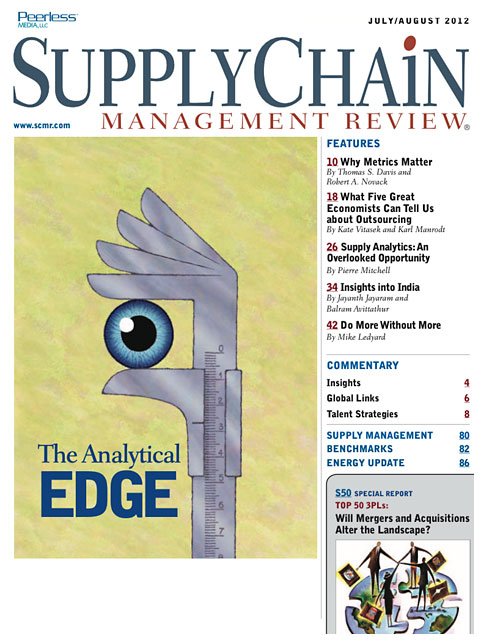Sorry, but your login has failed. Please recheck your login information and resubmit. If your subscription has expired, renew here.
July-August 2012
Managers sometimes don’t understand the importance of the information provided by supply chain metrics—or even the need for metrics in the first place. But according to researchers from Penn State, having timely and accurate metrics in place leads directly to superior business performance. They make a strong case for why supply chain metrics really do matter. Browse this issue archive.Need Help? Contact customer service 847-559-7581 More options
As companies work to elevate the value and sophistication of their products and services, they must also do the same for their “information supply chains.” This requires generating deeper insight and intelligence to uncover hidden risks and rewards from increasingly voluminous and fragmented data littered across internal and, increasingly, cloud-based databases. Supply chain analytics can deliver the needed intelligence and insight. But to do so, the analytics needs to go beyond the silos (such as focusing only on forensic spending analysis in procurement) to layer multidimensional data modeling, visualization, optimization, and other technologies on top of a harmonized view of this data.
Supply chain analytics is a broad topic; it is typically focused on the customer/demand side to tune the demand-driven supply chain. However, the supplydriven side is just as important to assure the discovery and positioning of multitier supply, which requires reliable and cost-effective inventory, capacity, and supplier capabilities. We define supply analytics simply as analyses that support improved design and management of the inbound value chain. But, a simple definition doesn’t mean that the analytics are simple. True supply analytics goes well beyond supply planning against an S&OP (Sales & Operations Plan) and sharing it with suppliers. As the old quote goes: “Ginger Rogers did everything Fred Astaire did, but backwards and in high heels.” So when a heel breaks on the supply side (for example, the Japanese tsunami, Thailand flooding, and so forth), bad things happen.
Those “bad things” represent supply chain risk potential, which has become a subject of great interest to supply chain professionals.
 |
This complete article is available to subscribers
only. Click on Log In Now at the top of this article for full access. Or, Start your PLUS+ subscription for instant access. |
Not ready to subscribe, but need this article?
Buy the complete article now. Only $20.00. Instant PDF Download.
Access the complete issue of Supply Chain Management Review magazine featuring
this article including every word, chart and table exactly as it appeared in the magazine.
SC
MR
Sorry, but your login has failed. Please recheck your login information and resubmit. If your subscription has expired, renew here.
July-August 2012
Managers sometimes don’t understand the importance of the information provided by supply chain metrics—or even the need for metrics in the first place. But according to researchers from Penn State, having timely… Browse this issue archive. Access your online digital edition. Download a PDF file of the July-August 2012 issue.
 |
Download Article PDF |
As companies work to elevate the value and sophistication of their products and services, they must also do the same for their “information supply chains.” This requires generating deeper insight and intelligence to uncover hidden risks and rewards from increasingly voluminous and fragmented data littered across internal and, increasingly, cloud-based databases.
Supply chain analytics can deliver the needed intelligence and insight. But to do so, the analytics needs to go beyond the silos (such as focusing only on forensic spending analysis in procurement) to layer multidimensional data modeling, visualization, optimization, and other technologies on top of a harmonized view of this data.
Supply chain analytics is a broad topic; it is typically focused on the customer/demand side to tune the demand-driven supply chain. However, the supplydriven side is just as important to assure the discovery and positioning of multitier supply, which requires reliable and cost-effective inventory, capacity, and supplier capabilities. We define supply analytics simply as analyses that support improved design and management of the inbound value chain. But, a simple definition doesn’t mean that the analytics are simple. True supply analytics goes well beyond supply planning against an S&OP (Sales & Operations Plan) and sharing it with suppliers. As the old quote goes: “Ginger Rogers did everything Fred Astaire did, but backwards and in high heels.” So when a heel breaks on the supply side (for example, the Japanese tsunami, Thailand flooding, and so forth), bad things happen.
Those “bad things” represent supply chain risk potential, which has become a subject of great interest to supply chain professionals.
 |
SUBSCRIBERS: Click here to download PDF of the full article. |
SC
MR

Latest Supply Chain News
Latest Podcast

 Explore
Explore
Latest Supply Chain News
- 2024 Warehouse/DC Operations Survey: Technology adoption on the rise
- Benchmarking the complexity of ESG reporting
- Looking back at NextGen 2024
- The Corporate Sustainability Due Diligence Directive
- How to make your CFO a supply chain superfan
- AI is moving omnichannel closer to the customer
- More latest news
Latest Resources

Subscribe

Supply Chain Management Review delivers the best industry content.

Editors’ Picks





